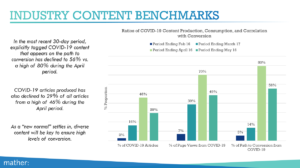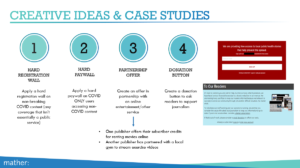By Dana E. Neuts – June 26, 2020
Subscription Insider – Link to Article
Since the COVID-19 pandemic hit the U.S. in mid-March, nothing has been the same. The coronavirus crisis has changed virtually everything we do, including how we buy and use subscriptions. Mather Economics, a global leader in subscription management and customer data analytics, has been tracking subscription trends across industries. Their president, Dr. Matt Lindsay, shared some key insights about trends in the media industry with Subscription Insider.
COVID-19 Content and Engagement Trends
As fear of the pandemic grew, consumers were eager for information, and news outlets responded by cranking up their content production. This, in turn, brought news outlets higher track and deeper engagement from existing customers, and it attracted many new prospects. Acquisition rates for newspapers and magazines tripled. The conversion percentage of highly engaged customers stayed the same, but the number of customers increased, Lindsay told Subscription Insider.
“Fulfilling the journalistic mission is critical during this time and its relevance should not be understated,” said Mather Economics in its COVID-19: Insights and Implications report. “However, during difficult economic conditions, taking proactive and thorough action to ensure long-term business sustainability is even more important than ever before.”
With a peak between March 18 and April 16, 2020, content production by media outlets, page views by readers, and conversions from readers into subscribers were significantly higher than in previous months. Those numbers have now tapered off to pre-COVID levels, but Mather says that diverse content will help media organizations ensure high conversion levels.


“We see that reader revenue is growing due to subscription volume growth but also through other revenue categories, such as affiliate marketing, incremental fees for add-on services, memberships, and ad-free experiences,” said Lindsay. “A focus on retention is now underway follow the COVID spike in new subscribers.
Here are some additional subscription trends that Mather is seeing:
- Less free content: publishers are lowering their meters or increasing the percentage of content designated as premium
- Lower prices: some publishers are making generous introductory offers to entice subscribers
- Longer promotional periods: longer time periods offset high churn that comes from low acquisition pricing
What to Expect in the Second Half of 2020
Mather anticipates several areas of risk – and also opportunities – for media organizations.
Potential risks
- New conversions and conversion rates are likely to decrease and return to pre-COVID-19 levels.
- “Fanatic” volume of engagement will return to the levels seen in March. Fewer people will engage with content and content providers enough to subscribe, which could also reduce conversion volume.
- New subscribers have a higher likelihood of churning as readers’ engagement with content decreases.
Potential opportunities
- Top-funnel and mid-funnel tactics like COVID-related newsletter sign-ups and breaking news alerts can convert readers into “fanatics.” By using these tactics, news outlets can continue to attract and engage readers, pushing them down the sales funnel toward subscribership.
- Media organizations can leverage this opportunity by renewing new subscriber on boarding tactics and developing targeted retention and pricing strategies based on content preference and level of engagement. Good reader data will help news organizations determine the best way to attract and retain those readers.
- News outlets can continue to engage existing subscribers through good on boarding practices, welcome email messages, prompts to sign up for breaking news alerts and non-COVID content. The key again is data – knowing what’s working and what isn’t will help news outlets to refine their sales and subscription practices.
- Affiliate revenue is another way for news outlets to grow revenue. The New York Times, Food52 and Active Interest Magazines are three organizations that have found that strategy to be successful.
- Implementing registration walls to capture emails in exchange for access to content can increase reader engagement. “Registration walls are important and a growing tactic here in the U.S. to grow the top of the sales funnel,” said Lindsay.
There are also organizations like The Boston Globe who use a high-priced strategy to attract readers. Priced at $30 per month, the news outlet offers high quality content and, therefore, is not as concerned about losing digital revenue as some of its lower-priced counterparts. As of early May, The Boston Globe had 205,000 digital subscribers. According to editor Brian McGrory in a Zoom meeting with the Society of Professional Journalists’ New England chapter, the recent growth has been due to the newspaper’s coverage of the COVID-19 pandemic.
“It took us seven years to get our first 100,000 digital-only subscribers, and about 11 months to get to 200,000,” he said, adding: “The rise has been substantial, gratifying, and important in terms of supporting our journalism…. We’re the only metro paper that could support the current size of its newsroom through revenue from digital subscribers.”
During this time, the newspaper kept its COVID-19 coverage behind a paywall, but it did offer promotional pricing to entice prospects to subscribe. Its rationale for that was that it offered free pandemic coverage at Stat News and Boston.com, both owned by The Globe, reports Dan Kennedy for WGBH. McGrory is hoping the newspaper can retain those subscribers after the pandemic is over and subscription pricing returns to regular levels. The Globe is doing that through outreach, virtual events and by considering a loyalty program for new subscribers.
Mather shares additional creative ideas and case studies.

Recommendations
Mather Economics offers the following recommendations for news outlets to make the most of this opportunity to attract and retain subscribers:
- Offer basic and breaking COVID-19 news free but let it count toward the metered paywall limit.
- Offer a free registration wall on COVID-19 content to gather prospects’ email addresses.
- Keep in-depth coronavirus coverage behind a paywall.
- Leave paywalls in place for non-COVID-related content.
- Communicate rules and offers with readers, so they have clear expectations.
- Ask readers to donate whether it is sponsoring a subscription, donating to a good cause or directly to the newspaper.
- Encourage print subscribers to active their digital subscriptions.
- For returning site visitors, entice them to read non-COVID-related content to build the reader relationship.

